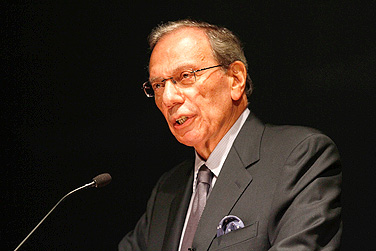News
A view from inside the economic crisis

Harvey R. Miller, senior partner in the law firm Weil, Gotshal & Manges LLP, talked about the Chapter 11 bankruptcy cases of General Motors and Lehman Brothers at the Gerald S. Lippes Speaker Series. Photo: COURTESY UB LAW FORUM
Students, faculty, alumni and turnaround professionals packed the Screening Room in the Center for the Arts last week to hear a recounting of the fast-paced implosion of some of America’s best-known companies—events that, it is now known, brought the world economy to the brink of collapse.
Harvey R. Miller, senior partner in the New York City-based international law firm Weil, Gotshal & Manges LLP, provided an insider’s view of the events leading up to the commencement of the General Motors and Lehman Brothers Chapter 11 bankruptcy cases based upon his experience as one of the lead attorneys for the companies in those cases.
Miller’s talk was part of the Gerald S. Lippes Speaker Series, a joint venture of the Law School and School of Management. The series, funded by an endowment by Lippes, a 1968 graduate of UB Law, seeks to foster an integrated understanding of the worlds of business and law and to encourage collaborative dialogue between business and legal professionals. The lecture also was sponsored by the Upstate New York Chapter of the Turnaround Management Association.
Miller set the stage by reminding his audience of the heady days of the 1990s stock market boom. Under Federal Reserve Chairman Alan Greenspan, Miller said, the financial services industry was deregulated and responsibility for policing the industry “was to be done primarily by the markets, with [Securities and Exchange Commission] oversight. The theory was that banks and financial institutions were best capable of protecting their clients and shareholders.”
Also during that time, he said, the industry came to believe that “a dollar saved is a dollar lost, and every dollar must be put to work.”
“The business of banking, including commercial and investment banks, changed dramatically as the trading function grew to become the prime locus of operations,” Miller said.
The result, of course, is only too clear in hindsight: a rash of highly speculative investments, including risky mortgage loans, that precipitated the nation’s financial crisis in the fall of 2008.
“It evolved into a classic bubble, which grew larger and larger,” Miller said—until the chain reaction of investments, which depended on continuing liquidity to sustain itself, fell apart.
When that happened, Miller said, the fallout was incredibly rapid. He told of some of the events of Sept. 12-15, 2008, which led to the Chapter 11 bankruptcy filing of Lehman Brothers and its subsequent acquisition by the British investment firm Barclays.
And so there were stories about a series of Federal Reserve Bank meetings in New York City and a fast-moving chronology of board meetings, urgent phone calls and hastily assembled purchase offers.
“There really was no alternative” to Lehman’s bankruptcy filing, Miller said: “We had no money.” After a sleepless weekend for all concerned, the petition was filed electronically at 2 a.m. “It was the skinniest bankruptcy petition ever filed. It barely met statutory requirements.”
Then the firm’s assets had to be sold—and quickly. “We’re talking about selling all these assets, and over the week they are just disappearing” as the stock market fell at a dizzying pace, Miller said. “Lehman was like a shipload of herring sitting at a pier. If you didn’t unload it, it would smell up the whole city pretty soon.
“The two primary drives are greed and fear,” he said. “And when fear dissipates, greed takes over. That’s what’s happened on the street. That’s what happened when traders took control of these companies.”
Miller also spoke about the bankruptcy reorganization of General Motors, in which the U.S. government became the company’s majority owner.
GM had a set of problems, he said: It was losing market share, its “legacy” pension costs and health insurance costs were huge, and its major union, the United Auto Workers, was inflexible—to the point that at one time the company was paying 5,000 union members in a union-negotiated “job bank” to play poker and watch TV all day.
The company’s problems came to a head when the banks started to refuse to refinance GM’s operating debt, creating an insurmountable cash-flow problem. Miller told of being summoned to GM headquarters in Detroit and having to park in the company’s garage and take a private elevator to the chairman’s office. The concern was that even a whisper of bankruptcy would damage the company beyond repair because “No one will buy a vehicle from a bankrupt company.”
In the waning days of George W. Bush’s presidency, the U.S. Treasury issued the loan that would save GM—closing the loan at 11:45 p.m. on Dec. 31, 2008. “Without that loan,” Miller said, “GM would be gone.”
Weil, Gotshal & Manges entered General Motors’ Chapter 11 bankruptcy filing on June 1, 2009, with a pre-negotiated purchase of the company by the government in hand. Again, it was a rush job—even by the U.S. Bankruptcy Court judge. He produced an 87-page opinion stating why the bankruptcy had to be approved, and he wrote it in a day and a half.

Reader Comments